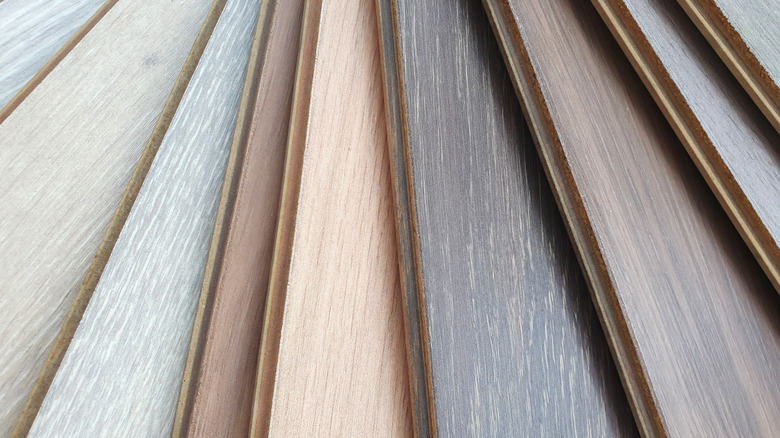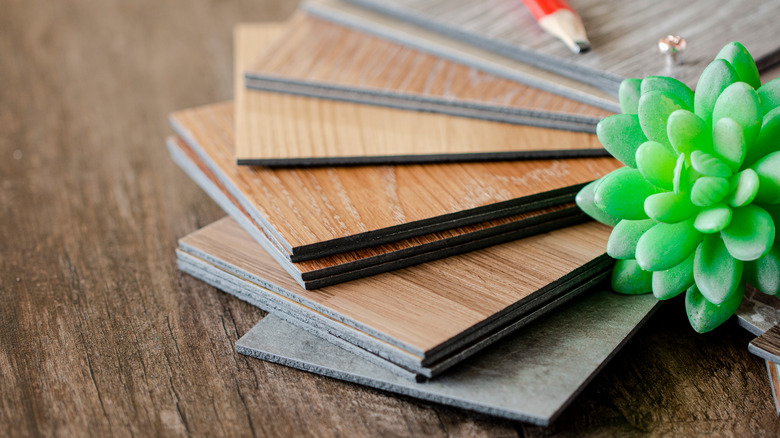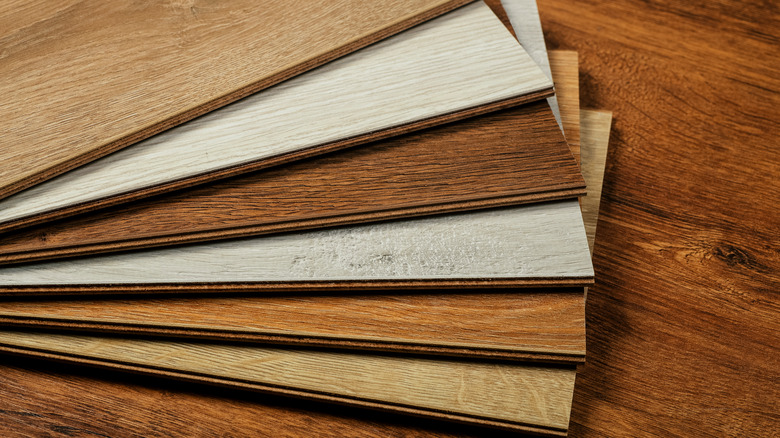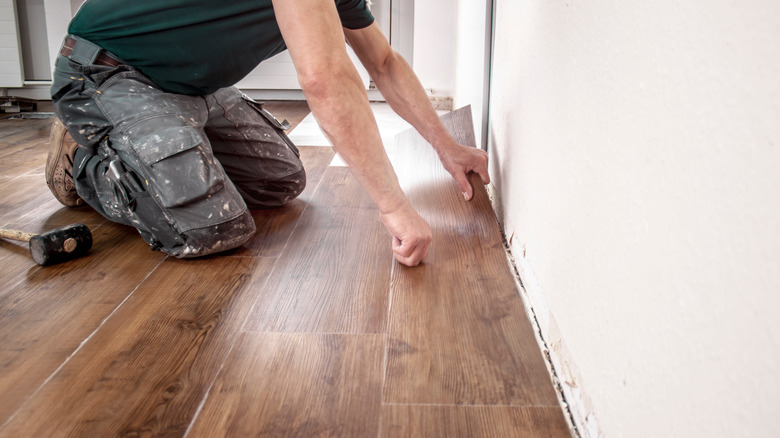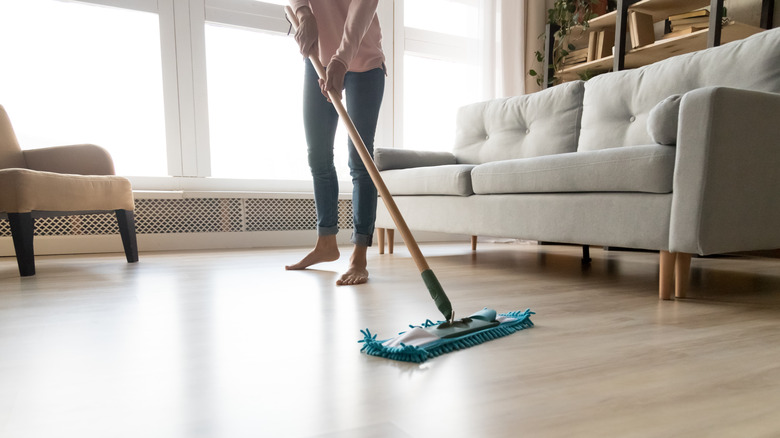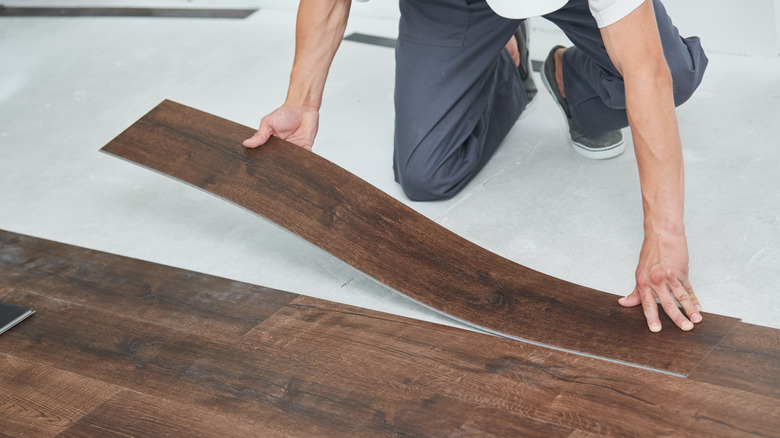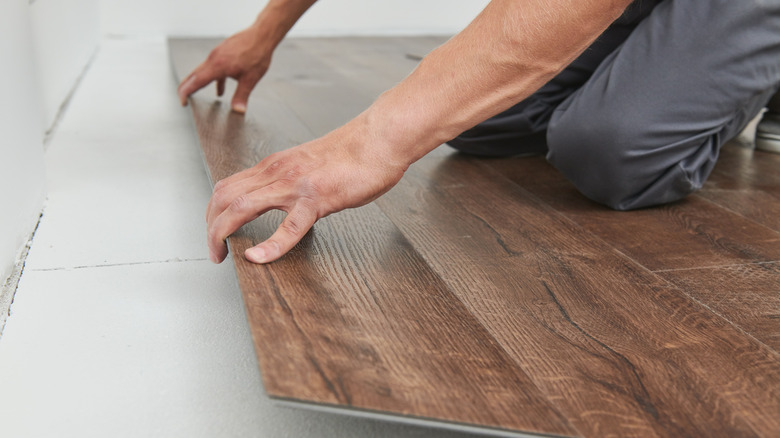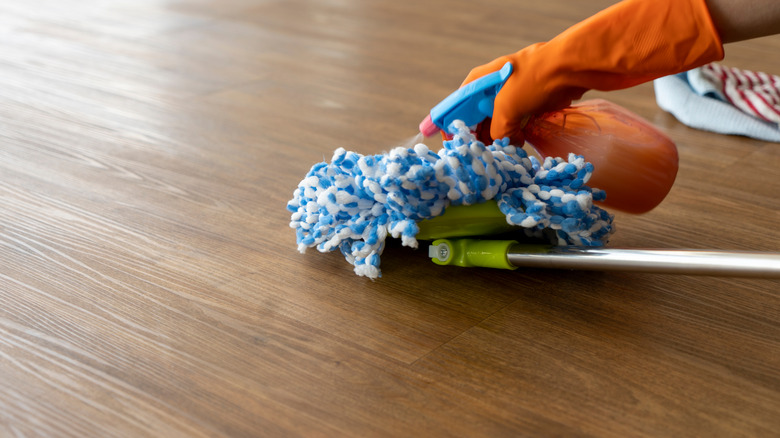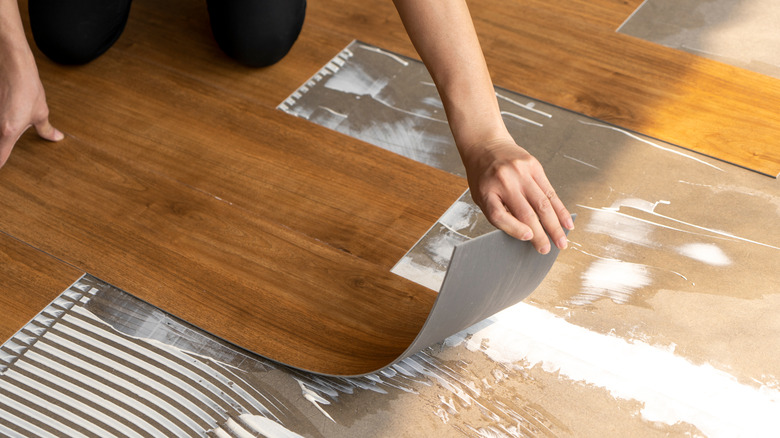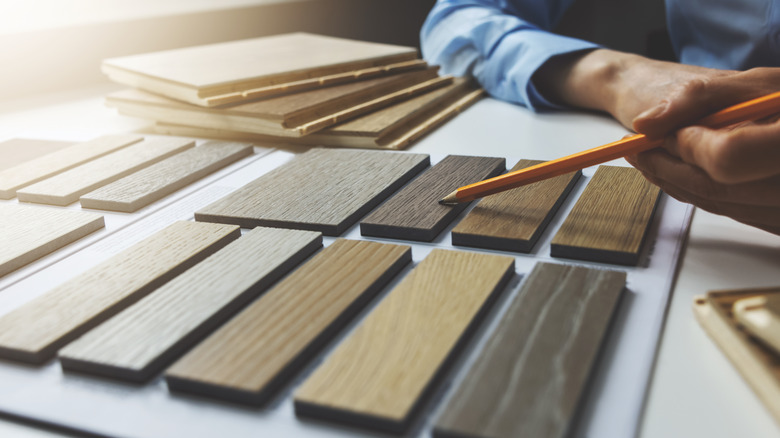Vinyl Vs. Laminate Flooring: What's The Difference?
If you're looking to refloor a room in your house and want something durable and wear-and-tear proof, you've likely come across both vinyl and laminate in your search. The two materials are very popular for people renovating or building homes, as they are extremely durable and resistant to spills, scratches, and general weathering.
Modern vinyl and laminate floors are very similar, if not most of the time identical, in appearance, often made to mimic the look and feel of hardwood, but much more stain and scratch-resistant. There are quite a few differences between the two materials, though, including how and what they're made of, overall durability, price, and more. For one, vinyl is usually made of six total layers, This Old House says, whereas laminate is made up of four at max, sometimes only three (via FlooringStores). The materials used in these layers are also different, although there are many more distinctions between the two than just composition.
Vinyl flooring composition
One of the main differences between vinyl and laminate flooring is how they're made and their composition. Vinyl is made up of polyvinyl chloride, or PVC, and became popular in the middle of the 20th century, according to This Old House. There are two different types of vinyl flooring — softer sheets that are made from fiberglass strands coated in PVC that are then woven together to create something similar to a rug, and thicker, sturdier tiles that are made up of vinyl and ground limestone.
Vinyl comprises six total layers. At the very bottom is a base layer that supports the other five. Above that is a sheet of fiberglass and then a cushion layer, so there's some give and bounce. The third layer has the pattern, which gives the vinyl flooring its final look — whether that's wood planks, limestone tiles, retro patterns, etc. The second layer is made to protect the pattern from damage, and the top layer adds a nice sheen, gloss, or matte finish while protecting the wear layer.
Laminate flooring composition
On the other hand, laminate flooring is made up of multiple materials which are similarly layered on top of each other the way vinyl is. At its most basic level, laminate flooring has just three layers. Higher-end laminate flooring will have an extra fourth base layer.
The first or base layer of laminate flooring, which is not always included, is a backing layer, also called an underlayment. According to FlooringStores, this coating has multiple potential uses, including either creating a moisture-resistant base or making it soundproof.
If your laminate flooring doesn't have a backing layer, the real first layer is the core, which comprises either fiberglass or plywood. This overlay will be very high-density for stability and longevity. The second layer is the image layer, which, like vinyl, can either mimic wood, tile, or another flooring material. The final coating is the wear layer and is very tough and sturdy. It provides protection against scrapes, scratches, and dents, as well as offers a nice finish, whether glossy or matte.
What are the differences in cost?
A significant difference between vinyl and laminate flooring is the overall cost. However, they are both considerably less expensive than high-end hardwoods, which still aren't as durable as the aforementioned flooring materials.
According to FlooringStores, laminate flooring costs anywhere from $1 to $10 per square foot, depending on design options and luxury upgrades (backing layer or underlayment, heated padding, etc.). Vinyl flooring tends to be much cheaper than laminate, with Forbes saying that average tiles and planks tend to cost around $2 to $3 per square foot. So even luxury vinyl doesn't get to be more expensive than $5 per square foot.
That's just the cost of materials, though. There's an additional charge per square footage if you want professional installation. For laminate floors, that price tends to be roughly $1 to $5 per square foot. Vinyl plank flooring installation costs around $7 per square foot, or between $36 and $45 per hour, while simple vinyl sheets installation may be around $3 per square foot, Forbes notes.
What are the differences in odor?
One major difference you may not think about when it comes to vinyl versus laminate flooring is the odor. While all floors can accumulate and trap unpleasant scents over time, vinyl is known to off-gas for a period after installation. Off-gassing refers to the release of volatile organic compounds (VOCs) released after installing the flooring and also happens when you paint or open up a new mattress (via What Is Vinyl). So while it's unpleasant, it's essentially harmless. If you have asthma or other sensitivities, though, proceed with caution.
Off-gassing usually lasts for three to five weeks, but the smells can get trapped in other areas of your home and cycle. To avoid this, try opening your vinyl flooring outside and letting it air out a bit before taking it inside to install. You should also do your best to ventilate all the rooms it's being installed in. Lastly, cleaning your floors and the room you're installing the floor in regularly can help release the smells. On the other hand, laminate flooring has no unpleasant odors associated with installation.
Pros and cons of vinyl flooring
Vinyl flooring is preferred by many over other flooring options, largely tile and hardwood, for a variety of reasons. For one, it's much cheaper than traditional hardwood or tile, as well as significantly more durable. There are also endless possibilities for customization not found in natural flooring materials. Finally, it's quite easy to install, Forbes notes.
It's not a perfect material, though. As mentioned earlier, the VOCs released at installation are very unpleasant and potentially lingering. While it is a durable material, it's not invincible, either. Sharp or very heavy objects can scratch and dent the floor, and while vinyl is easy to install, it's not easy to uninstall. In addition, vinyl shouldn't be laid on top of other vinyl, as it makes the installation process a little tricky. Finally, vinyl is far from the most environmentally conscious material in the world, with Citizen Sustainable saying it's made from crude oils that aren't biodegradable or sustainable and are harmful to harvest and manufacture.
Pros and cons of laminate flooring
Laminate flooring has its own unique set of pros and cons. Beginning with the pros, laminate flooring is relatively inexpensive in comparison to other flooring options on the market, as well as incredibly durable to natural wear and tear. According to Forbes, laminate flooring is also much more environmentally friendly than other flooring options and is often made from recycled materials. Finally, it's quite easy to lay it yourself.
As for cons, while laminate flooring is durable, it isn't the most durable. In addition, it is particularly susceptible to moisture damage. Spills are a cause for concern with laminate flooring, but more than that, water seeping into and under the planks is very dangerous for its longevity. Luckily, there are plenty of waterproof options now available. Finally, laminate flooring can't be refinished once it starts to look worn down and must be completely replaced.
Durability and maintenance
Both vinyl and laminate are fantastic options for people looking for a low-maintenance and long-lasting flooring material. They aren't identical in their life spans or maintenance, though. According to America's Floor Source, vinyl flooring can last as long as 10 to 20 years if properly cared for. In addition, they are much more resistant to stains and spills and usually have a specific layer to protect against those things. For how durable it is, vinyl flooring is still typically soft and yielding under your feet. In terms of maintenance, it simply needs sweeping and mopping.
Laminate flooring is just as, if not more, long-lasting than vinyl flooring, with Forbes stating it lasts an average of 15 to 25 years. Laminate flooring is also easy enough to maintain, but it's a little more complicated than vinyl. All materials used to clean need to be labeled as laminate safe. All spills need to be cleaned immediately, and you shouldn't mop more than once a month with a damp mop, either. You'll need to lay down rugs, too, as the floor can't just be repaired or refinished but will need to be entirely replaced if there's noticeable damage.
Installation difficulty
One of the major benefits of vinyl and laminate flooring is how easy they are to install. If you choose to hire professionals to install the flooring, it is a quick and relatively inexpensive process. However, if you choose to do it yourself, it is even cheaper and just requires a little bit of elbow grease.
Vinyl flooring comes in either plank or peel-and-stick form. Peel-and-stick is just what it sounds like — you simply peel the adhesive backing off the back of the strip, line it up where you want it, and lay it down (via Lowe's). Plank floors are a more specific process but essentially involve you laying down one row of planks and then connecting all the subsequent planks in a floating, locking method.
Laminate flooring is a little more complicated to lay down than vinyl. While vinyl flooring comes in already assembled planks or sheets, laminate requires you to install each individual layer, per Home Depot. As with vinyl, you must clean and prep the subfloor and measure your planks. Then, you install the underlayment, the core, the image layer, and the wear layer.
When to choose vinyl flooring over laminate flooring
The decision between laminate and vinyl flooring can be difficult since both flooring materials offer very similar options in terms of price, longevity, and installation. However, there are enough small differences that can help you decide what's best for you.
Laminate flooring may not be the best option for those with small kids or pets. While durable, scratches or dropped heavy objects can still damage the appearance. In addition, as Forbes points out, laminate flooring can't be refinished, and major damage means the entire floor will have to be replaced. Laminate also isn't a great option for bathrooms, laundry rooms, or areas with lots of water and moisture.
Vinyl flooring is a lot more durable and can weather heavier scratches, spills, etc. However, vinyl does off-gas, which can be upsetting for young children, pets, or those with sensitive respiratory systems, even if just for a few weeks. If you want an environmentally conscious home, vinyl flooring is certainly not a good option.
